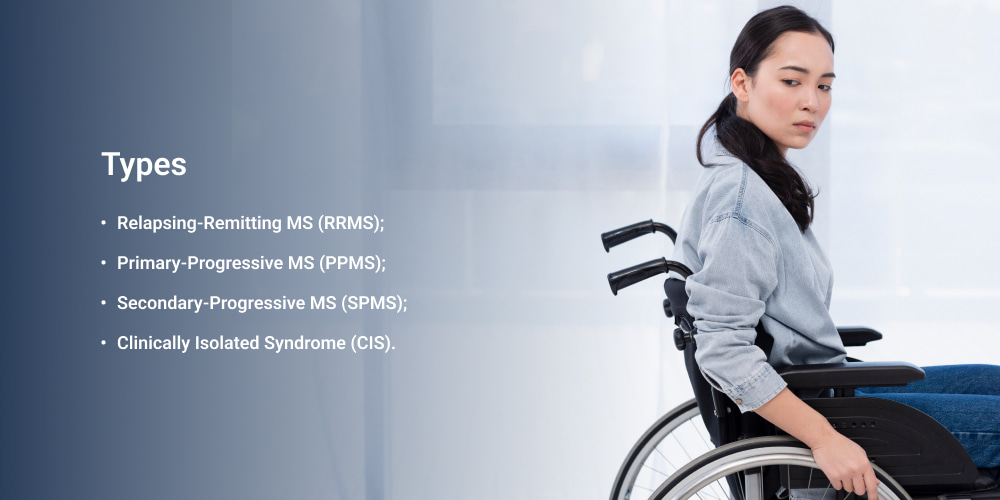Multiple sclerosis, sometimes known as MS, is a neurological disorder. The immune system targets the protective sheath that surrounds nerve fibers, destroying them and interfering with communication between the brain and other body components.
MS is classified into different types. Each kind has distinct symptoms and necessitates a unique treatment strategy. This article will examine each kind of multiple sclerosis and the therapies that are available.
4 Types of Multiple Sclerosis
Multiple sclerosis is a neurological disease that affects the brain and spinal cord. There are four different types, each with its unique symptoms. They are:
- Relapsing-Remitting MS (RRMS).
- Primary-Progressive MS (PPMS).
- Secondary-Progressive MS (SPMS).
- Clinically Isolated Syndrome (CIS).
But there are less famous and active forms of that syndrome. They are:
- Radiologically isolated syndrome (RIS).
- Balo disease.
- Burned-out MS.
- Inactive or benign MS.
- Progressive-relapsing MS.
Knowing which type of MS you have is essential for getting the proper treatment.
Relapsing-Remitting MS (RRMS)
This is the most prevalent kind of MS, accounting for around 85 percent of all cases. RRMS is distinguished by symptom flare-ups (relapses) followed by periods of remission in which symptoms diminish or cease completely.
Primary-Progressive MS (PPMS)
Primary-progressive MS (PPMS) is the rarest form of the disease, accounting for only about 10 percent of all cases. PPMS is characterized by a gradual worsening of symptoms from the start, with no periods of remission.
There is currently no known cause of PPMS and no cure. Treatment focuses on managing symptoms and slowing the progression of the disease. The prognosis for that multiple sclerosis is generally worse than other types of MS, with most people experiencing a gradual decline in their physical and cognitive abilities over time.
PPMS has no established etiology, although experts believe it is caused by a mix of genetic and environmental factors. There is no cure for PPMS, however therapies can help control symptoms and delay the disease’s course.
PPMS symptoms might vary from person to person however they may include:
- Symptoms appear gradually.
- Symptoms intensify over time, with no intervals of remission.
- Fatigue.
- Muscle fatigue.
- Walking is difficult.
- Spasticity (muscle stiffness).
- Problems with the bowel and bladder.
- Dysfunction in sexual relationships.
- Pain.
- Depression.
Secondary-Progressive MS (SPMS)
Secondary-progressive MS (SPMS) is the most common type of multiple sclerosis. It is characterized by gradually worsening symptoms, with or without periods of remission and relapse.
The cause of SPMS is unknown, but it is thought to be due to accumulated nerve damage over time. Treatment for SPMS is similar to that for RRMS, but the focus is on managing symptoms and preventing further disease progression.
SPMS is a progressive form of MS, which means that it gets worse over time. The rate of progression varies from person to person, but most people with SPMS will eventually require mobility aids or be unable to walk. There is no cure for SPMS, but treatments can help to manage symptoms and slow the progression of the disease.
Clinically Isolated Syndrome (CIS)
The initial episode of neurological symptoms lasting at least 24 hours is referred to as clinically isolated syndrome (CIS). Damage to the myelin sheaths that wrap nerve cells causes it. An MRI scan can reveal this lesion.
CIS can occur at any age but is most common in young adults. The most common symptom is optic neuritis, which can cause vision loss due to optic nerve inflammation. Other symptoms may include weakness, numbness, and tingling in the limbs.
CIS does not always progress to multiple sclerosis (MS), but there is a greater risk if certain factors are present, such as a positive MRI scan or a family history of MS. The prognosis for CIS is generally good, but it is essential to see a doctor if any new neurological symptoms occur.
Other Types of MS
There are five varieties of multiple sclerosis, each with its own set of symptoms and prognosis.
-
Progressive-relapsing MS.
Progressive-relapsing MS is a less common form of the disease characterized by a gradual worsening of symptoms (progression) from the start, with periods of symptom flare-ups (relapses) along the way.
-
Inactive or benign MS.
Benign multiple sclerosis is a kind of relapsing-remitting MS. This is a kind of illness in which new or worsening symptoms are minor or do not appear for an extended time. That explains why doctors take so long to diagnose it.
However, around 15 years after your initial MS diagnosis, your doctor will be able to determine if the illness is benign or not. They use an MRI and the Expanded Disability Status Scale (EDSS) to determine your level of physical impairment. The exam lasts between 15 and 30 minutes.
-
Burned-out MS.
Burned-out MS is a term used to describe a form of the disease that is characterized by a significant decrease in symptom activity after years of living with relapsing-remitting MS. While there is no cure for MS, burned-out MS is considered to be a more benign form of the disease and generally has a better prognosis than other types of MS.
-
Balo disease.
Balo disease is an uncommon type of multiple sclerosis characterized by a quick onset of symptoms and involvement of several nervous system regions. Balo disease is regarded as a particularly aggressive type of MS, with patients frequently facing a bleak prognosis.
-
Radiologically isolated syndrome (RIS).
Radiologically isolated syndrome (RIS) is when people have lesions on their brain or spinal cord that are typical of MS but do not yet have any neurological symptoms. RIS is generally considered a precursor to MS, and people with RIS have an increased risk of developing the disease.
The prognosis for each type of MS is different, and it is essential to speak with a doctor about what to expect. People with relapsing-remitting MS generally have the best prognosis, while those with primary-progressive MS have the worst. However, it is essential to remember that each person is unique and that prognosis can vary from person to person.
While there is no cure for MS, treatments available can help manage symptoms and slow the progression of the disease. Speaking with a doctor about the best treatment options for you is essential.
Diagnosis of Multiple Sclerosis
MS is a chronic, inflammatory demyelinating disease of the central nervous system (CNS). There is no one test that can offer a conclusive diagnosis of MS. A physical exam will be performed by your healthcare professional to determine what is causing your symptoms. Blood tests and imaging tests, such as an MRI, may also be performed. An MRI scan searches for lesions (damaged regions) in the brain or spinal cord that indicate multiple sclerosis.
Bottom Line
It’s essential to take care of your health for many reasons. Doing so can help prevent or manage health conditions and improve your quality of life.
Health care providers often group different types of multiple sclerosis (MS) based on how the disease first presents and the predominant type of lesions (areas of damage) in the central nervous system. So, remember that self-care can harm your health. It’s better to contact a specialist for the best treatment.
With good health, you have no problem. To maintain it at the required level, you should approach this comprehensively. The Lone Star Neurology will help you to deal with your diseases correctly and effectively.
They have experienced neurologists, who are not only professionals but also have compassion and empathy. Their nurses are not only friendly and helpful but also highly qualified. Their qualified technicians and office staff work to improve our patients. You can treat:
- Migraines.
- Concussion.
- Epilepsy.
- Stroke.
- Memory Loss.
- Carpal Tunnel Syndrome.
- Diabetic Neuropathy.
- And others.
And to get a professional touch on your health, you should use the contact button on the website. The specialists will provide high-quality help solutions.
FAQ
- How many types of multiple sclerosis are there?
There are four main types:
– Relapsing-Remitting MS (RRMS);
– Primary-Progressive MS (PPMS);
– Secondary-Progressive MS (SPMS);
– Clinically Isolated Syndrome (CIS).
- What is the most severe type of MS?
“Fulminate MS” is a rapidly progressive disease course with severe relapses within five years after diagnosis; also known as “malignant MS” or “Marburg MS,” this form of very active MS may need to be treated more aggressively than other forms.
- Which type of MS is the most common type?
Relapsing Remitting MS is the most common form of MS. About 85% of people with MS are diagnosed with RRMS. Typical symptoms include:
– Visual and oculomotor disturbances.
– Paresthesias.
– Weakness.
– Spasticity.
– Urinary disorders.
– Mild cognitive symptoms.













Please, leave your review
Write a comment: